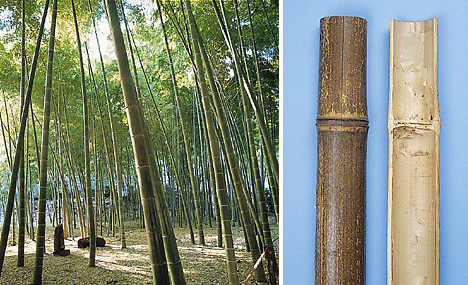Grass is one of the largest and most varied families in the plant kingdom. Some kind of grass can be found on almost all the land surfaces of the earth. Grasses grow in swamps and deserts; in subzero polar regions and hot tropical areas; on rocky land; and on cold, snowy mountains. Grasses range from the short kinds found in lawns to woody, tall bamboos from which cane fishing poles and furniture are made. Cereal grasses such as wheat, oats, barley, and corn are used to make bread, pastes, plastics, and many other products. Most sugar we eat comes from a grass plant called sugar cane. Brewers and distillers (liquor makers) use corn and barley in making alcoholic beverages. Paper can be made from the leaves and stems of some grasses. People can even convert certain grasses, including switchgrass, into fuel.

Grass also beautifies the landscape and plays an important part in conservation. It forms an attractive surface for lawns, parks, and playgrounds. It also helps to save the fertile topsoil from erosion (wearing away). Grass covers the surface of the soil, and its roots hold the soil particles together so that wind cannot easily blow them away and water cannot wash them away.
Grass, like other plants, is usually green because it contains a green-colored substance called chlorophyll. Through a process called photosynthesis, this substance helps change sunlight into energy that plants—and the animals that eat plants—can use.

The grass plant
A grass plant has two main parts—the vegetative organs and the floral organs. The vegetative organs include the roots, stems, and leaves. They keep the plant growing. The floral organs are the parts from which the flowers develop. They also produce the seeds from which new plants grow. These organs include the stamens (male floral parts), the pistils (female floral parts), and the lodicules (small scales that regulate flower opening). Grass flowers appear in clusters.
Grass has threadlike roots that absorb water and nutrients (nourishing substances) from the soil. Aboveground, the plant produces stems called culms, from which the leaves grow. Culms consist of nodes (joints) and internodes (areas between the nodes). The nodes are always solid. But the internodes of wheat and certain other grasses are hollow. Some grasses, including smooth brome, have creeping stems called rhizomes that grow below ground. Others, such as buffalo grass, have creeping stems called stolons that grow aboveground. Still others, including Bermuda grass and Japanese lawngrass, possess both rhizomes and stolons. Rhizomes and stolons spread out from the plant to start new plants.
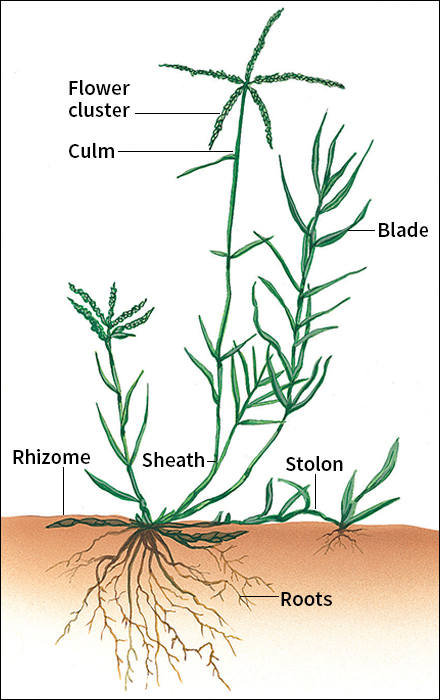
Grass leaves are called two-ranked, because each leaf grows on the opposite side of the culm from the leaf below it. The leaf’s sheath wraps around the culm above each node. The blade, which is sometimes incorrectly called the leaf, is fastened to the top of the sheath. It usually has a flat, narrow shape. The ligule grows where the blade and sheath meet. It may form a thin sheet or look like a row of eyelashes. In many grasses, a pair of auricles also grows where the blade meets the sheath. Auricles often resemble claws or ear lobes.
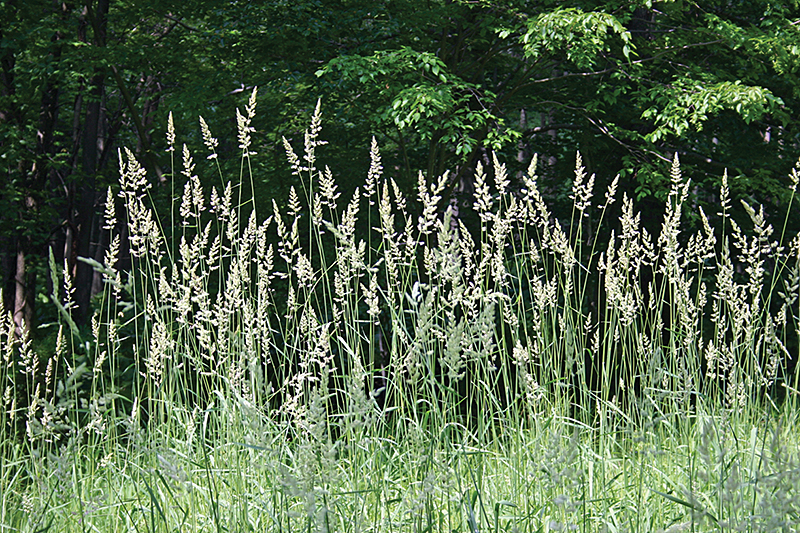
Grasses may be either annual or perennial. Annual grasses die at the end of the growing season, and growers must start new plants from seed at the beginning of the next season. Perennial grasses live through the winter and grow again each year.
Kinds of grasses
Grasses may be classified into six main groups. They are: (1) grazing and forage grasses, (2) turfgrasses, (3) ornamental grasses, (4) cereals, (5) sugar cane, and (6) woody grasses.
Grazing and forage grasses
provide most of the feed that animals eat. Grass is the principal source of food for such grazing animals as cattle, goats, horses, and sheep. In winter, these animals eat grass in the form of hay, straw, and silage (chopped up grasses and grains that are stored in a silo). Some important grazing and forage grasses are described in the table in this article.
Turfgrasses
are used to cover athletic fields, golf courses, lawns, and playgrounds. Some turfgrasses, such as colonial bentgrass, creeping bentgrass, Kentucky bluegrass, and ryegrass, grow better in colder climates. Bahia grass, Bermuda grass, carpet grass, centipede grass, and zoysia grass grow best in warmer climates. Buffalo grass, blue grama, and crested wheatgrass withstand hot, dry weather well. People from dry regions use these last three types for lawns that are not watered. The putting greens on golf courses often have coverings of bentgrass or Bermuda grass.
Ornamental grasses
possess beautiful, plumelike flower clusters. Growers use them in flower gardens, parks, and other landscaped areas. Common varieties of ornamental grasses include Chinese silver grass, pampas grass, and uva grass.
Cereals
rank among the world’s most important food crops. The seeds of the cereals provide grain that is ground into flour. The cereal grasses—wheat, rice, corn, oats, sorghum, and millet—are sometimes called grains or cereal grains.
Wheat
provides a major source of food. Wheat kernels can be ground into flour. People use wheat flour to make such foods as bread, noodles, and breakfast cereals. Wheat germ, bran, and malt also come from wheat. Wheat kernels contain a protein called gluten. This substance enables dough with yeast to rise by forming small pockets of carbon dioxide in the dough. Most wheat is called “bread wheat.” Bread wheat may be brownish-red or white. Durum wheat, also called macaroni wheat, makes macaroni, spaghetti, and other kinds of noodles. It may be yellow or brownish-red. Feed for cattle, poultry, and other livestock often contains wheat. Wheats are annuals that grow from 2 to 5 feet (0.6 to 1.5 meters) high. They have spikelike flower clusters.
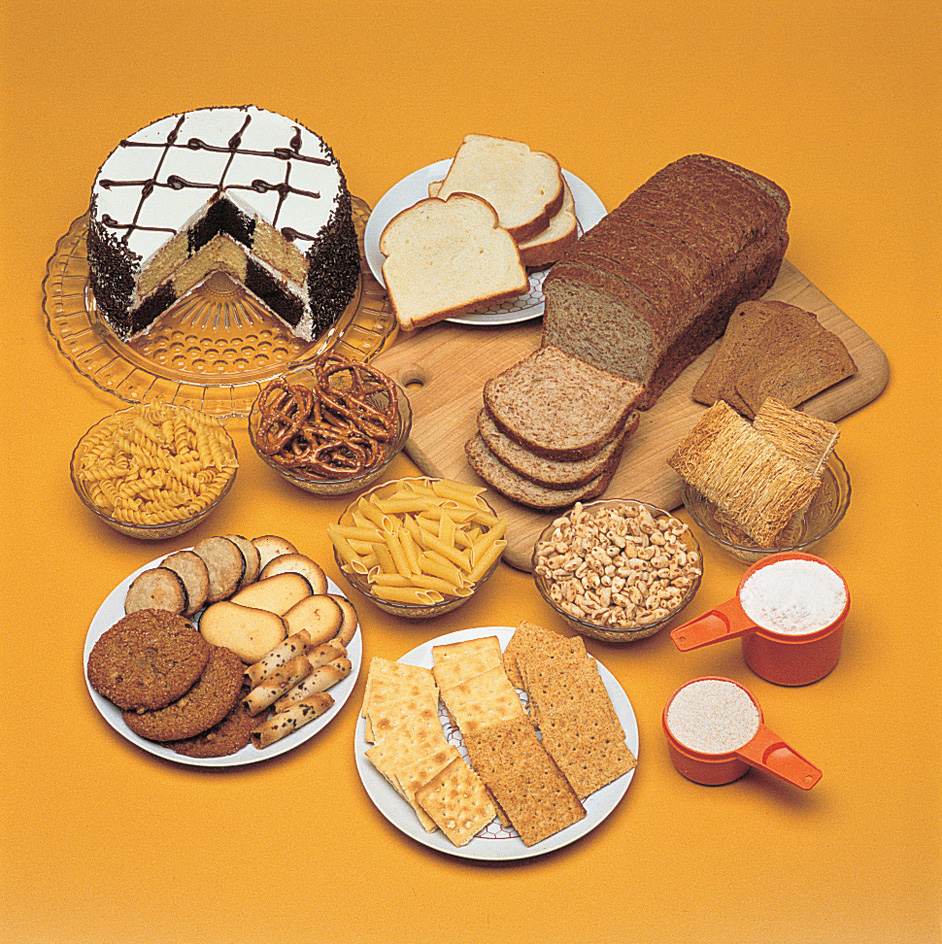
Rice
has served for centuries as a basic food for millions of people worldwide. Two major types of rice are lowland rice and upland rice. Lowland rice grows best on flooded land, while upland rice depends on rain to supply water for growth.
People eat rice in many forms. The white cooked rice we eat has been milled to remove the covering. It consists mainly of starch, a substance that provides the body with energy. People use rice and rice flour to make many kinds of breakfast foods. Rice also is used to produce alcohol, candy, cosmetics, glue, laundry starch, paste, and vinegar. Rice stalks provide straw for making brooms, hats, mats, rope, sacks, and sandals. In some parts of the world, rice straw is burned to heat houses. The rice plant, an annual, grows from 21/2 to 6 feet (0.8 to 1.8 meters) high and has a tight flower cluster.
Corn
is called maize in some countries. Corn provides a major source of food for livestock. Two varieties of corn, sweet corn and popcorn, rank among the most popular human foods. Manufacturers also make corn into meal, oil, and flour. Corn is an annual that grows from about 3 to 20 feet (0.9 to 6 meters) high. At the top of its stalk, it has a spikelike tassel, the male flowering structure. The ears, or female flowering structures, lie on the stalk’s side branches.
Oats
serve mainly as livestock feed. Livestock often consume oats in pastures during the warmer months. In winter, they may eat hay and silage that contain oats. Manufacturers use a small percentage of the oat crop to produce oatmeal. Oats are annuals that grow from 2 to 4 feet (0.6 to 1.2 meters) high. An open seed cluster grows at the tip of an oat’s stem.
Other cereal grains
include grain sorghums and millets. Farmers in some countries grow them mainly for livestock feed. In many other nations, people eat them.
Sugar cane
provides more than half of the world’s sugar supply. Sugar cane also produces a fiber called bagasse that is used in making wallboard, plastics, and fuel to heat homes. The sugar cane plant is a perennial that grows from 7 to 15 feet (2 to 4.6 meters) tall.
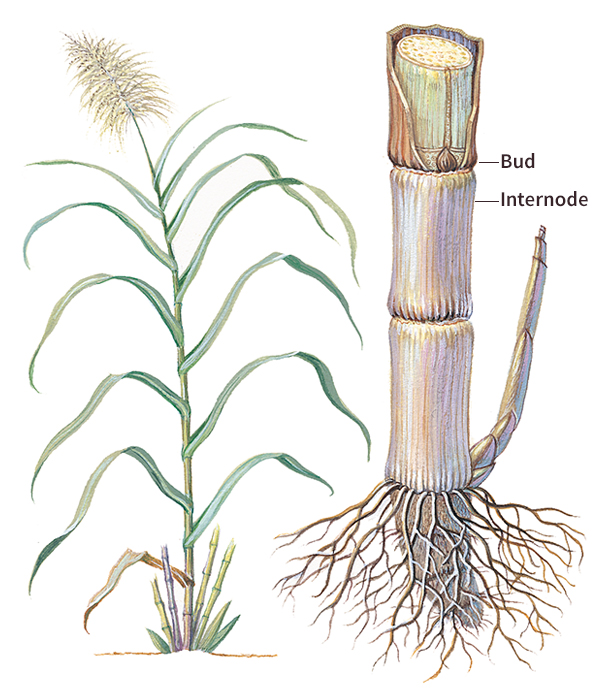
Woody grasses
include the bamboos. Bamboos have strong, woodlike stems that are used for building houses, rafts, bridges, and furniture. People can make boards of bamboo that measure 1 foot (30 centimeters) or more wide. Bamboo stems also can serve as water pipe when the solid nodes have been removed. Bamboos are perennials. They grow as high as 120 feet (37 meters) and measure 6 to 12 inches (15 to 30 centimeters) thick at the bottom.
